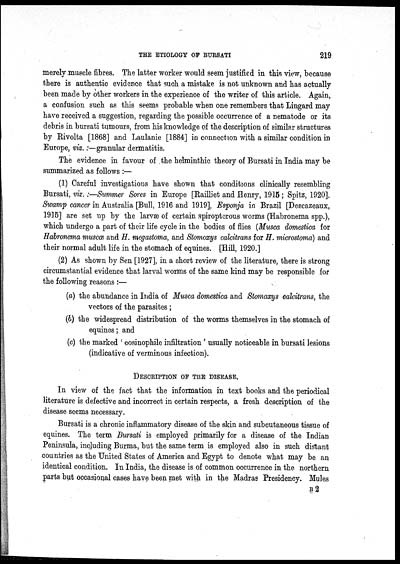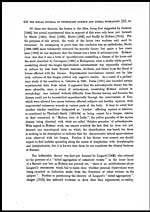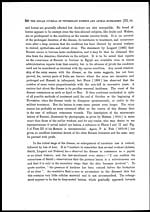Medicine - Veterinary > Veterinary colleges and laboratories > Indian journal of veterinary science and animal husbandry > Volume 3, 1933 > Original articles > Etiology of bursati
(277) Page 219
Download files
Individual page:
Thumbnail gallery: Grid view | List view

THE ETIOLOGY OF BURSATI 219
merely muscle fibres. The latter worker would seem justified in this view, because
there is authentic evidence that such a mistake is not unknown and has actually
been made by other workers in the experience of the writer of this article. Again,
a confusion such as this seems probable when one remembers that Lingard may
have received a suggestion, regarding the possible occurrence of a nematode or its
debris in bursati tumours, from his knowledge of the description of similar structures
by Rivolta [1868] and Laulanie [1884] in connection with a similar condition in
Europe, viz.:—granular dermatitis.
The evidence in favour of the helminthic theory of Bursati in India may be
summarized as follows :—
(1) Careful investigations have shown that conditions clinically resembling
Bursati, viz.:—Summer Sores in Europe [Railliet and Henry, 1915; Spitz, 1920],
Swamp cancer in Australia [Bull, 1916 and 1919], Esponja in Brazil [Descazeaux,
1915] are set up by the larvæ of certain spiroptcrous worms (Habronema spp.),
which undergo a part of their life cycle in the bodies of flies (Musca domestica for
Habronema muscæ and H. megastoma, and Stomoxys calcitrans for H. microstoma) and
their normal adult life in the stomach of equines. [Hill, 1920.]
(2) As shown by Sen [1927], in a short review of the literature, there is strong
circumstantial evidence that larval worms of the same kind may be responsible for
the following reasons :—
(a) the abundance in India of Musca domestica and Stomaxys calcitrans, the
vectors of the parasites ;
(b) the widespread distribution of the worms themselves in the stomach of
equines; and
(c) the marked ' eosinophile infiltration' usually noticeable in bursati lesions
(indicative of verminous infection).
DESCRIPTION OF THE DISEASE.
In view of the fact that the information in text books and the periodical
literature is defective and incorrect in certain respects, a fresh description of the
disease seems necessary.
Bursati is a chronic inflammatory disease of the skin and subcutaneous tissue of
equines. The term Bursati is employed primarily for a disease of the Indian
Peninsula, including Burma, but the same term is employed also in such distant
countries as the United States of America and Egypt to denote what may be an
identical condition. In India, the disease is of common occurrence in the northern
parts but occasional cases have been met with in the Madras Presidency. Mules
B 2
Set display mode to: Large image | Zoom image | Transcription
Images and transcriptions on this page, including medium image downloads, may be used under the Creative Commons Attribution 4.0 International Licence unless otherwise stated. ![]()
| Permanent URL | https://digital.nls.uk/75230305 |
|---|
| Description | Covers articles from 1933. |
|---|




